A Beginner’s Guide to the epic kosmische music of Tangerine Dream
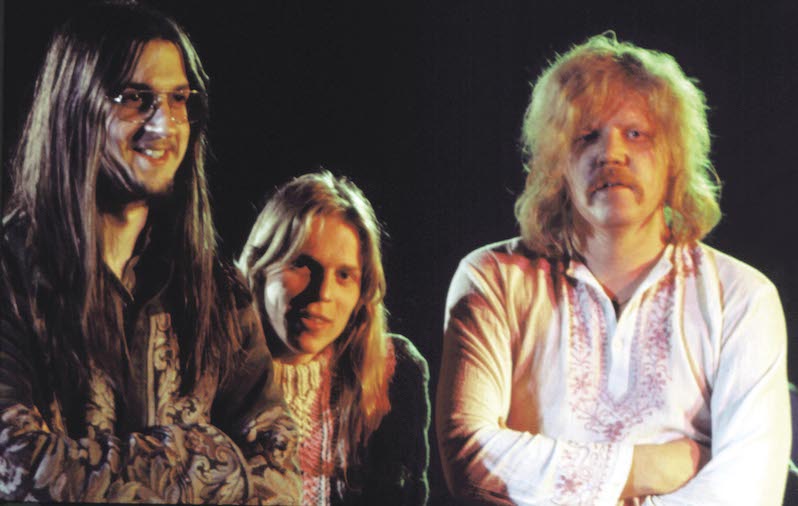
Summing up the decades-long and still-ongoing career of Tangerine Dream quickly evolves from simple to impossible the longer you stare at the problem. The shortest description would be: “The kings and founders of kosmische music.” In a pinch, this would do. It helps, for instance, that it’s undeniably true. While the genre they helped develop had other practitioners and to some avant-rock cognoscenti the true wielders of the throne are Can (or, perhaps, Kraftwerk), it is instead to Tangerine Dream that I must hand the crown. Their blend of icy synthesizers and dreamlike ambiance developed far afield from what the colliding worlds of rock and roll and progressive music had developed thus far, seizing upon the space music of early Pink Floyd and expanding it to the very outer limits of the sound. While we often discuss the parallels of rock, pop and jazz to orchestral works in terms of programmatic intent, very few bands ever, let alone their peers, have so thoroughly crossed that bridge from this side as Tangerine Dream have.
That they would become a go-to group for soundtrack work for decades then feels like an obvious development in their career. To date, they have done 36 soundtracks spanning the years 1977 to 2013, including of all things two separate released soundtracks for Grand Theft Auto V. This is on top of over 100 live and studio albums. Normally, one would filter out live albums from a written project like this entirely, but kosmiche is a funny beast, being a direct precursor to techno and house music as much as a derived form of rock. As such, live albums are often less about prepared compositions, playing the hits so to speak, and more about spontaneous improvisation around little stems and musical ideas left lying around. As a result, the vast portion of these live albums contain wholly original material, not unlike the way peak fusion Miles seemed to pour off hour-plus live improvs like it was turning a tap on and off. This doesn’t count the mini-albums, EPs and remixes which only extend the total runtime and total sonic ground explored by their works even further. They have mined this sound for decades and, without a doubt, they have explored seemingly every inch of it.
The group, to their credit, is not to be deterred by this fact. Even the death of their founders has not stopped them; they have remained an active group under new membership and have utterly reenergized themselves, releasing the spectacular Quantum Gate in 2017 and the year-end worthy but woefully under-listened Raum in 2022. As such, given these vast decades of works, with a debut from the late 60s and a current record from this year and just shy of 200 releases total between then and now, not to mention their rightfully legendary status, they are a group as ripe as any for a Beginner’s Guide, some way to make sense of that vast body of work and offer inroads to parsing the endless hours of wonder they provide. I started this project near the beginning of the pandemic. In the interest of completeness, I disregarded my editor’s idea of going for the obvious records, feeling it was perhaps the easy way out, and chose instead to listen through the entire body of work to find the precise five that were best to understand and open up this group. That tale, or a truncated version of it, is appended at the end if you are interested in the long process which inevitably proved a simple, repeating truth: My editor was right. In the following selections, we have included choices from their studio and soundtrack work, both to highlight the obvious starting points as well as the hidden angles of their sound and what makes this group so special. These are arranged in rough suggested listening order.
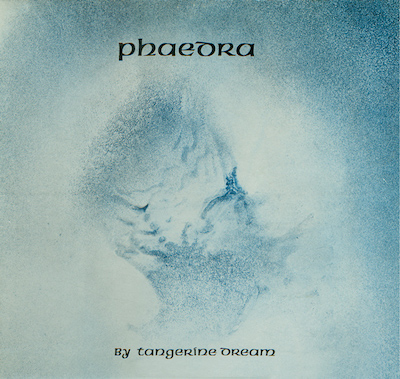
Phaedra (1974)
In all respects, this is the one. When it comes to kosmiche, no album reigns above Phaedra when it comes to elaborating on what this particular approach to space music means. It is the Close to the Edge or the Kind of Blue of its style, not just the purest but also the best encapsulation. Sure, some may prefer other records over it (I myself lean toward Klaus Schulze’s Mirage) but this one is the undisputed top of the mountain. As mentioned before, Tangerine Dream was one of the founders of the style but not necessarily the first to ever play it. SImilarly, this isn’t their first record but, for all intents and purposes, they began anew here. There is a parallel to be drawn in progressive music to King Crimson’s debut being a watershed moment, not the first album of a style but the start of a style, if you catch the difference; similarly, see Black Sabbath’s debut as the moment for heavy metal compared to the number of (very good!) records of the style that came before it.
The beauty of Phaedra is in how its ambient sensibilities cascade with quiet but undeniable force into the psyche, ebbing and churning like waves of a gradually rising tide, heat and cold in deep sea water buried below your mind’s eye breaking into chopping storm before you realize it. Put this record on and pick up a book, turn on a film with the sound muted, attempt to hold a conversation. You’ll find your mind burning, the colors melt into one another, your mind tunnels inward to memory and abstraction. Your speech becomes more animated. You are impelled with great invisible force. We discuss, culturally, the notion of drugs as mind-altering; they have little power compared to this record. The ephemeral cover, gesturing toward a head laced in veins but never quite becoming clear, captures the ineffable beauty of this album. A general problem with art is one of specificity versus ambiguity. Country music, for instance, benefits greatly from its intense granularity of its stories, a trait shared by the more crenelated and curious wings of progressive rock. Pop, meanwhile, typically thrives on the generalized, seeking to speak to something more archetypical in experience than a specific moment in life and time. Here, Tangerine Dream define in perfection what the psychedelic and space musicians had been striving for over the past roughly decade of work: a way to stoke the inward heart, to make a music that speaks to the self within the self rather than the thinking or even archetypical mind. When therapists strive to unlock the inward angst and anti-experiential/anti-materialist movements of the spirit within, they should grab this album.
Listen: Spotify
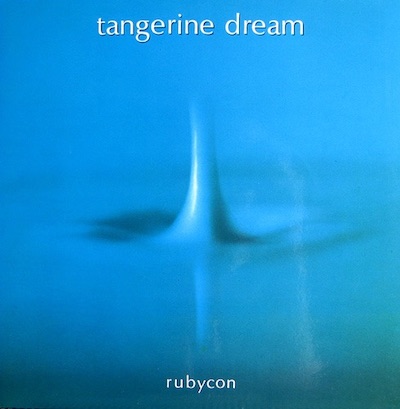
Rubycon (1975)
It is fitting, then, that the sister album to the most perfect jewel of the style would also find its way onto this list. It’s odd; though the record is a single long-form composition, it somehow has slightly less epic sweep as Phaedra‘s smaller pieces. However, in Rubycon we see a change in psychic vistas, elaborating well the breadth of color and shape this group has. Where Phaedra dwelt in the psychic cold, ice forming in the vacuums of space buried beneath our minds, Rubycon has the gentle reassurance of birds, sea wind, sand, light. There still exists the presence of water but here it is rendered as bubbles, the movement of fish, a surrounding warmth. That last part is perhaps the biggest change between Phaedra and its twin; warmth. Eventually, an arpeggiator begins to churn, breaking up the expository beach scene we are introduced to, ushering in a sense of conflict, pursuit, predators in the jungle, guns emerging from the foliage. This is one place Rubycon has a clear claim to something Phaedra doesn’t. In this record, we can begin to see why they were pursued for so many soundtracks. The images come quickly and freely; the fact that this isn’t a soundtrack is perhaps more surprising than anything, given the robustness of the mental images it conjures. Where its predecessor taps the most powerfully into those subliminal forces of the mind, our lust and rage and desire that runs counter to the flow of history and experience, this record summons up experiences from the raw materials of the mind. Entire groups like Pinkish Black, No Spill Blood and more likely wouldn’t exist without the developments shown on this record.
Listen: Spotify
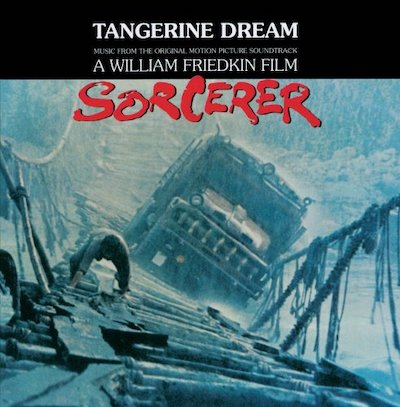
Sorcerer [Original Soundtrack] (1977)
We would be remiss not to include on of Tangerine Dream’s many soundtracks here to best plumb the depths of what this band has brought to the table over their decades of existence. On paper, this seems perhaps like a strange pairing: on one side, the space music pioneers Tangerine Dream, best known for scoring the scabrous tumult of the womb-like oceans of the mind; on the other, William Friedkin’s masterpiece film about driving trucks laden with nitroglycerine through the decaying jungle roads of South America. It turns out, however, that these are a match made in heaven. The film itself uses its grimy setting, between the involvement in crimes both organized and spontaneous by its protagonists and the surrounding violences and pressures of the world, to use its jungle journey as a non-racist reworking of Heart of Darkness, formulating the fraught jungle trek as a complex imagistic metaphor for descent into the hellish depths of the mind and being. Tangerine Dream are, of course, perfectly at home here, wielding the skills they honed on both Phaedra and Rubycon to draw taut the threads connecting these two spaces. The conjunct of image and sound, the shots of Friedkin and the music of Tangerine Dream, negates the distance between the physical and the psychic, the literal and the metaphorical; the film sweats madness and anxiety from every pore and, in your seat, you are driven deep into desolation. The soundtrack holds up played on its own, as well, a trait that can be said for many of their works and explains their constant draw to this format. Still, this soundtrack, their very first, is the exact moment the filmic and imagistic elements of their music went from being latent to literalized and concretized and from it all of those other works flow, arguably never better achieved than this perfect synthesis of image and sound.
Listen: Spotify
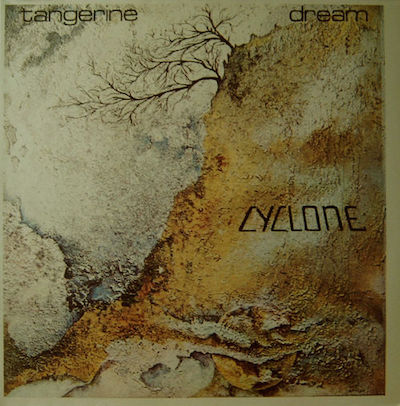
Cyclone (1978)
For those in the know: This one holds the spot that might otherwise be taken by Stratosfear or Ricochet, two of the three records between this one and Rubycon. That intervening period saw the band exploring a more and more keenly melodic sensibility driven in part by greater inclusion of acoustic instruments, including flutes, real strings and drums. This record, however, features the one crowning change that will mark their most successful melodic work: vocals. It is a rarity for Tangerine Dream and one that certain diehards may consider heretical to place above certain works of theirs (including the aforementioned Stratosfear or the earlier Zeit and Atem). But take a listen to album opener “Bent Cold Sidewalk” alone to see the point; this record bridges the difference between the cosmic explorations of the post-psychedelic progressive electronic musicians and the traditional prog and art rock of the time, playing like a lost peak-era Genesis epic with its stately grandeur if if featured vocals by Jon Anderson of Yes. These melodic sensibilities would later develop into outright New Age compositions in later years, producing a wing of their work that drew from their compatriots Mike Oldfield and Vangelis, witnessing the spiritual component of their work in parallel to the imagistic, psychological and progressive elements. That the back half of this record effloresces into a 20-minute meditation is just icing on the cake.
Listen: Spotify
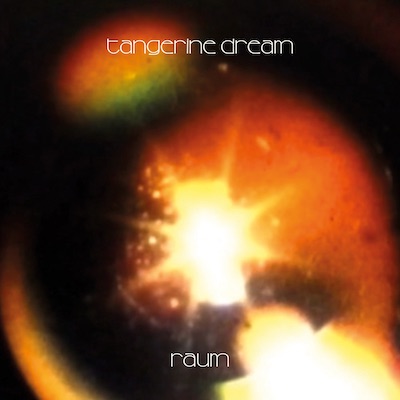
Raum
It may be shocking to some to see their newest album here instead of one of the many, many other golden era records from the group. There’s even a case to be made for some of their more curious and satisfying soundtracks, such as their icy cool production for Risky Business or the thrilling kosmiche of their soundtrack for Thief. There’s even a case to be made for certain outside choices, such as Starmus – Sonic Universe, their live record with Brian May, or Turn of the Tides, certainly the group’s great New Age record on par with Yanni and Enya at their best. But choosing this, their latest, serves to underscore two points: first, that the group has retained the capacity for making incredibly, luxurious, deep and emotive records over their entire 50-plus-year career and second, that the group is still in capable and evolving hands under the stewardship of Thorsten Quaeschning. We are in an eerie and uncanny age, one where older groups are reuniting, stirred from their long slumbers, or else there is a sudden renewed interest in those that never left, only to reveal that the works they are making are not just adequate records to keep the flame alive but satisfying additions to the legacy. Tangerine Dream join their fellow space rockers in Hawkwind and their fellow Germans in Eloy as a group that has rediscovered their vivacity over the past decade or so, rising capably from the seas of records good for fans only to once again making records worthy of the attention of all ears. This, ultimately, is what makes them such an all-time act. It is not just the greatness of their early innovations or their contributions to form and approach to music but also their continued ability to produce emotionally startling and revelatory compositions played with a deep and abiding sense of heart.
Listen: Spotify
As promised: A brief tale. This originally was pitched just before COVID. I had already satisfactorily written the Beginner’s Guide to King Crimson, a piece whose title mirrors to my satisfaction the name of an already-existing compilation put out by the band itself, and I had established myself in my zeal as the Treble community’s dominant proghead. We all listen to quite a lot and share quite a bit of musical interests with one another, often discovering quite a bit of records and groups from the process of writing and discussing as a team, but we each have our strong suits and progressive music happened to be mine. Given similar reviews in the past plus an upcoming anniversary for… one of their albums, certainly, we had a quick discussion and I jumped at the chance to write the beginner’s guide for such an illustrious group. After a few quick emails, my editor made a point that the choices were already fairly obvious; there were, after all, just a touch over five records that are considered the ideal starting point for the band already and there wasn’t any great need to reinvent the wheel. Given that even the five-record limit is more a soft rule than a hard rule, the article appeared to write itself. All it needed was the prose and insight itself, the real stuff that makes a writer and critic happy.
But I was not satisfied with this. Oh no. I had my own professional standards to uphold, I insisted, and didn’t want to simply churn out the easy article for quick cash and the nods of my peers. I had made previous articles like this after fastidiously listening through not a portion but the entirety of a body of work, no matter the size, so that I might be absolutely thorough in my selections of ideal starting points. After all, it is not the job of a critic, I argued, be it of music or anything else, to simply regurgitate the canon. We must be bold, have our own voices, be willing to cry out for reconsideration of forgotten artists and works as well as reduction in position of previously idolized works. I am, after all, one of the many who declares Station to Station to be the superior Bowie record, not Low; that Dylan’s Christian era is as woefully underrated as his current honky-tonk obsession; that the lack of real literacy of country music in the indie music world is criminal. It was my job, no, my duty, I argued, to go through the whole body of work, well over a hundred albums total, to make damn sure the choices were right.
My editor, god bless his soul, realized I was once again on one and, beautiful patient heart that he possesses, decided to let this wild horse roam free on their foolish errand even if the fruits of it would be inevitably what we expected.
Then the pandemic hit in full force. I already had a number of bigger projects in my lap; I’m Listening To Death Metal was drawing to a close with its unlucky chapter 13, a retrospective of Cynic was being tidied up, and I still had I’m Listening to Progressive Rock continuing to unfurl in my mind as much as on the page, not to mention Neil Peart’s sudden passing thrusting me into a long-form exploration of the full body of work of Rush. All at once, I was given a cluster of things: time, time, too much time, which clung in acrid clouds; the space madness of the pandemic and isolation; and over one hundred records of kosmische and New Age. So, between reviews, between my day job, between the same battles with health and politics and sanity we all encountered in the pandemic, I would track down Tangerine Dream records, one after another, press play and take notes.
It turns out my editor was right.
Now, I don’t consider this a wasted venture. At some point, these notes could turn into a damn fine piece, when I’m willing to read back and find narrative and critical architecture across that many fucking albums. And hey, for this one at least, it turned up a few albums I could use to fill the back end, using three or four picks for the obvious ones that, bless his heart, my editor told me ahead of time would wind up making the cut anyway by virtue of their greatness, leaving one or two on the end for dark horse picks that show the breadth and deeper character of the group. I’d mapped out similar for my David Sylvian piece, wanted to highlight not just the couple obvious all-time greats of his discography but also at least one of the records that true musos cling to as sign of him being one of the best to ever do it. Only this deep practice with the group could have provided that list of alternative and more exciting picks. Then, after all that, I picked their most recent anyway, because it contained all those same exciting elements but made a strong narrative.
Ah, well. Raum hadn’t even been recorded yet by the time this project kicked off, let alone released, so there was no way it would establish itself so firmly as a great bookend had that time not been taken. Everything shakes out the way it does for a reason, even if it’s not always a very good one. And at least it provided a good and classic story about the conflict between youthful ambition and zeal and the wisdom of an editor and mentor’s time in the fields.
Support our Site—Subscribe to Our Patreon: Become one of our monthly patrons and help support an independent media resource while gaining access to exclusive content, shirts, playlists, mixtapes and more.
Langdon Hickman is listening to progressive rock and death metal. He currently resides in Virginia with his partner and their two pets.


If ever an honorable mention be necessary, let it be here and let “Poland: The Warsaw Concert” be the choice as a showcase of their talent and live presence. Performed under the Iron Curtain in December 1983, the band was one of the few Western bands to play in the Communist country because the lack of lyrics appeased the state-controlled censors. Add to it the power outages and brutal cold during the shows, the classic lineup of Froese, Franke, and Schmoelling shine brightly as a magnificent showcase of a band at their prime with arguably their best roster.
I’m with you on “Station to Station”, but
“Low” is pretty friggin’ good.